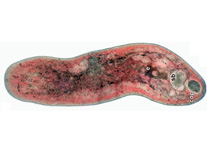Abstract
Surveys conducted on horsetails, Equisetum spp. (Equisetaceae), in Serbia led to the discovery of a new eriophyoid mite genus while searching for a classical biological control agent against these weeds in New Zealand. Eriocaenus gen. n. is described based on the type species Aceria equiseti Farkas, 1960 (transferred to Eriophyes by Farkas 1965; herein reassigned to the new genus) and Eriocaenus ramosissimi n. sp., a new species discovered on Equisetum ramosissimum Desf. in Serbia. Eriocaenus equiseti (Farkas, 1960), previously only known from Hungary, was found in Serbia for the first time on Equisetum arvense L. and Equisetum telmateia Ehrh., and is redescribed. Species descriptions include line drawings as well as phase contrast (PCLM), differential interference contrast (DIC) and scanning electron (SEM) micrographs. The differential diagnosis between the two Eriocaenus species is supplemented by molecular differentiation of 28S rDNA sequences including D2 fragments for both mites.

